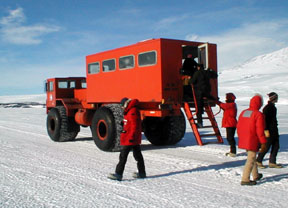
A Delta.
We were having record setting warm weather, it was -2 C and the ice was getting rotten. So a lot of people signed up for the last tour to the ice caves in the Tongue of the Erebus glacier. The sign up said wear your ECW gear. Eventually 18 souls crammed into the back of a huge wheeled vehicle known as a Delta.

After we were settled the driver said,"I'd like t add a visit to the Barne Glacier and Scott's hut at Cape Evans, we won't get back until 1 AM." Ouch I was going to snow school AKA happy camper school for the next two days so I needed my sleep, but I wanted to see the ice caves even more so I stayed with the crew and off we went.
They made us wear our seat belts, and we could see why as we crossed "the transition" between the land of McMurdo station and the sea ice. The delta rocked and rolled, we began to notice the fracture patterns in the windows which looked like they were made by the impacts of heads.
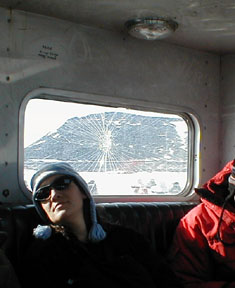
First stop was the Barne glacier, an ice cliff that rose 150 feet above the fast ice. It was great to be able to actually walk up to the end of a glacier. The glacier pushed on and cracked the sea ice.
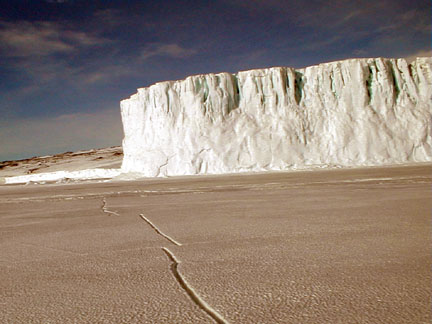
The glacier also pushed up blocks of the ice. Other passengers went over to the ice blocks and licked them and proclaimed them salty. It was the first time I had ever seen ice licks for humans. I knew better what to do with the blocks...I climbed them.
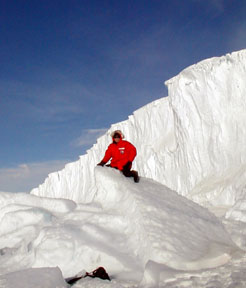
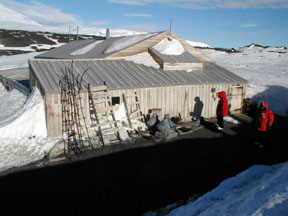
Midnight, Dec 1, 2001 we arrive at the hut that was built by Scott's expedition on their way to the pole.
The inside of the hut has been preserved in something like its original condition.
I am here as a part of the Exploratorium team to report on science being done in Antarctica today. However science was an important element of Scott's expedition. Edward Wilson's work table is still covered with apparatus.
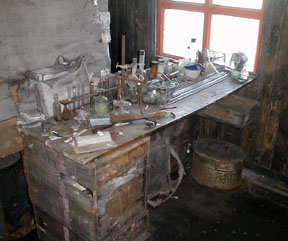
My wife Ellen and I often read aloud to each other while on long car trips . One day, while reading about Scott's expedition to the pole, we read that he planned to use Siberian ponies to haul his sledges. Because of the snow he needed to equip them with pony snowshoes. The concept of a pony snowshoe was so incongruous that we both laughed ourselves into tears. As I looked around the hut I saw one bunk draped with pony harnesses and tack. Hanging there were two circular disks which could only be pony snowshoes. I broke out laughing once again and attracted the attention of the other visitors.
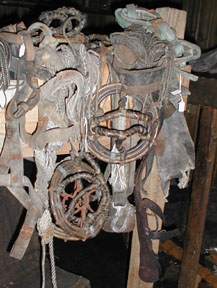
While looking around the hut I also spotted the expedition bicycle. The leather seat and rubber tires had survived better than the steel frame.
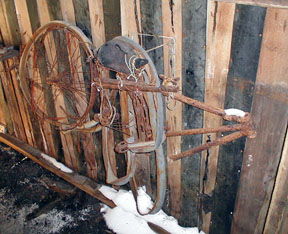
Scott was ahead of his time, almost 100 years later we see people riding mountain bikes on the roads of McMurdo station.
Scott also had skis and dogs but chose to man haul his sleds to the pole and with tremendous effort he made it, only to find Amundsen's Norwegian tent waiting for him. He and four companions did not make it back alive.
We drove on to the Ice Caves of the Erebus glacier tongue. A rope attached to the wall with ice screws aided our entrance into the cave. Inside it opened up into a large room with smooth walls and an ice stalactite covered ceiling. Deeper in the cave sunlight filtered through the ice becomes a glowing blue light that attracts light scattering physicists like me just as a candle attracts moths.
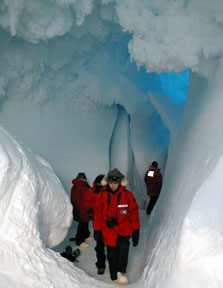
I went toward the deep blue part of the cave, and looked up at the ceiling.
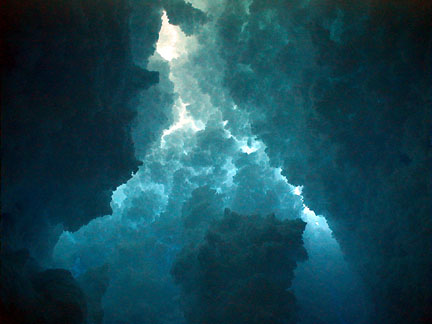
Cracks in the roof lead toward the surface. The more ice that the sunlight passed through, the deeper blue it became.
Here's the science:
Visualize the head of Mickey Mouse, you are picturing a water molecule. His head is the oxygen and his ears the hydrogen of H2O. The hydrogen "ears" of lone water molecules vibrate side to side with a resonance in the infrared, thus water absorbs infrared radiation and is a greenhouse gas. However, when water molecules join together in ice, or liquid water, the "ears" of one molecule become hydrogen bonded to adjacent oxygens. This raises the frequency of vibration into the red part of the spectrum so that pure ice absorbs red light. Thus, white sunlight becomes blue after passing through clean ice. Antarctic glacier ice is some of the purest on earth. Even air bubbles are squeezed out of glacier ice when it becomes a few hundred feet thick, and so the ice becomes a beautiful blue color.
At 1 AM a sunbeam entered the mouth of the ice cave and traversed the entire length of the cave.
I remembered Jules Verne and looked at the point where the beam hit the end of the cave, searching for an entrance to the cave that would take me to the center of the earth...alas I must have been in the cave on the wrong day, perhaps the sunbeam on the solstice would show me the way?
In the beam, ice crystals that had condensed from our breath did a three dimensional dance flashing brightly like dust motes on steroids.
As the beam glanced along one wall it illuminated frost patterns on the wall.

Looking at the patterns, I saw a hand print. I felt as if I were in an icy, ephemeral Lascaeux cave.
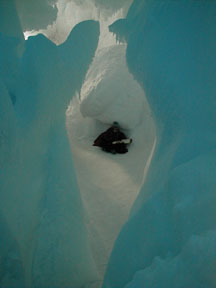
One of the women on our tour brought along her water colors. Following in the footsteps of watercolor artist Edward Wilson she attempted to capture the feeling of the cave.
Saturated with blue light we made our way back to the Delta for the ride home and at 2 AM I got into bed, tired and happy.
|
Scientific Explorations with Paul Doherty |
|
3 Dec 2000 |